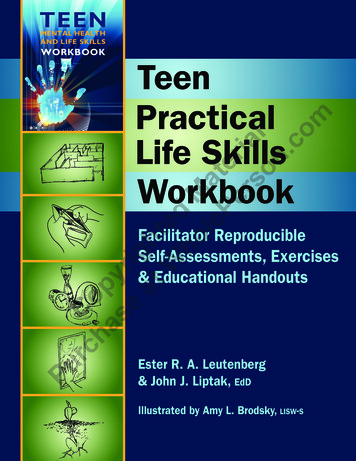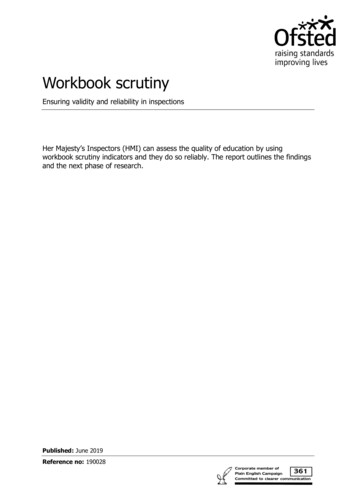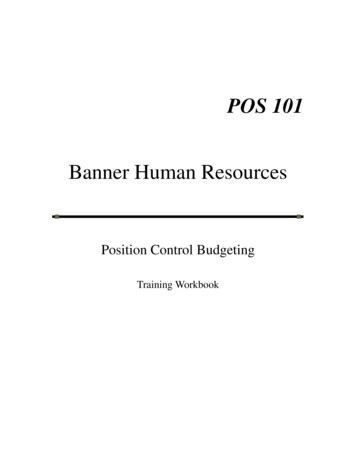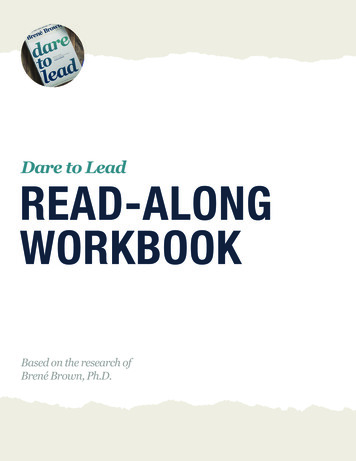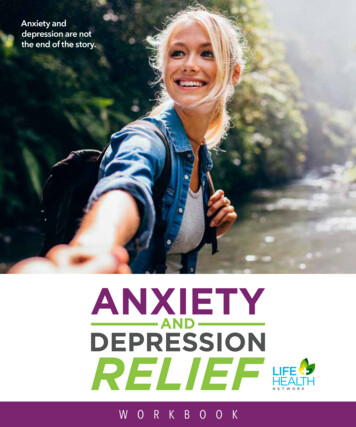
Transcription
Anxiety anddepression are notthe end of the story.LIFEHEALTHN E T W O R KW O R K B O O K
W O R K B O O KLIFEHEALTHN E T W O R Klifeandhealth.orgabide.network
LIFEHEALTHN E T W O R KLife and Health Network is a 501(c)(3) non-profit health media organization createdby a group of physicians and dentists who all share an earnest desire to do more thanthe norm. True health shouldn’t be merely about diagnosing symptoms and prescribingmedication—it is far more valuable than that.How? Simple—balanced nutrition, regular fitness, and a positive state of mind. The goalof Life and Health Network is to seek the plain, science-backed truth and to share it withyou through:Healthy recipes, cooking videos, articles, and otherwellness resources all for free at lifeandhealth.org.Abide Network is a group of counselors and coaches who offer trainings, seminars,retreats, and both in-person and distance (via telephone or video chat) counselingand coaching. We are wholistic, scientifically-informed, and biblically-grounded.1st Printing. Copyright 2020 by Life and Health NetworkAll rights reserved. No part of this publication may be reproduced, distributed, ortransmitted in any form or by any means, including photocopying, recording, or otherelectronic or mechanical methods, without the prior written permission of the publisher,except in the case of brief quotations embodied in critical reviews and certain othernoncommercial uses permitted by copyright law. For permission requests, write to thepublisher, addressed “Attention: Permissions Coordinator,” at the address below:110 Flocchini Circle Suite 400Lincoln, CA 95648lifeandhealth.orgISBN: 978-0-9895575-6-6Printed in China.
May each page of this workbook touch your life with theinformation and inspiration you need to rewrite your health story.
Introduction“Humans are 90% water. We’re basically cucumberswith anxiety.”–@JackBinstead“Mental pain is less dramatic than physical pain, butit is more common and also more hard to bear. Thefrequent attempt to conceal mental pain increasesthe burden: It is easier to say, ‘My tooth is aching’than to say, ‘My heart is broken.’”—C.S. LewisMaybe you’ve felt mental pain—the dull ache we calldepression. Depression says the end of hope hascome. It says nothing will ever be good or bright orworth smiling about again. It says life is heavy andbleak; you’ll never have anything but failure; you’renot good enough for what you want in life, and you’llnever get it no matter what you do.And anxiety? Those debilitating, oftentimes groundless, feelings of worry or fear strong enough todisrupt our ability to function, to work, to love, or tostay healthy are so universal that they trump everyother category of mental illness.Depression and anxiety don’t care who you are orwho you know or how much money you have in thebank. It doesn’t matter if you’re rich, poor, educated,talented, popular, or simple and low-profile, gorgeous or homely or somewhere in between.The good news is, this lack of hope, these worries—they’re lying to you. The bad news is, it feels likethey’re telling the truth.Dealing with depression and anxiety starts withunderstanding. Know thine enemy, because if youshine a light on the darkness, the darkness will disappear. The physical, psychological, spiritual causesof anxiety and depression must first be identifiedand addressed in order for us to find relief. And thatis what we want to share with you in this course.Your past bad days don’t have to overshadow thedays ahead. You can live big, and you can fight. Yourlife can be made into a great adventure story.We’re with you for this new story of hope andcourage. Our goal for this course is to walk with youstep-by-step, guiding you with time-tested, scientifically-proven ways for you to heal. You’re bigger thanfear, you’re even bigger than hopelessness—and youcan overcome and outlive the darkness and the worry. Join with us in this adventure of healing.LIFEHEALTHN E T W O R KJennifer Jill Schwirzer, lpc, ncc5
ANXIETY & DEPRESSION RELIEF WORKBOOKSESSION 1 Introduction to AnxietySESSION 2 Introduction to DepressionSESSION 3 Treating the Body Part ISESSION 4 Treating the Body Part IISESSION 5 Treating the MindSESSION 6 Treating the HeartWORKBOOK ANSWER KEYRESOURCESNOTE: This workbook is designed to be used with Anxiety and Depression Relief course.Learn more at lifeandhealth.org.102642526286108113
TOOLBOXMental Health ChecklistCheck the things that apply to you.oooooooooooooooooooooooooooo8Family history of mental illnessEarly childhood trauma or abusePrevious episode of mental illnessFamily history of substance abuseExtreme home of origin dysfunctionChildhood divorce/parental absenceLow birth weightWidowedRecent major life stressBrain injury or defectPre-menstrual syndromeMenopause or perimenopauseRecent birthSingle parentingMajor life stressors, even if positiveLiving with an addictWeather/time of yearSerious marital conflictOther serious home life conflictRaising grandchildrenChronic pain/health problemsRegular insomniaSevere povertyIllnesses that can cause depressionLow self-esteemPoor social skillsOveruse of social mediaUrban settingAn ounce of prevention isworth a pound of cure.—BENJAMIN FRANKLINooooooooooooooooooooLack of social supportIrregularity in scheduleToo little sleep ( 6 hours/day)Too much sleep ( 9 hours/day)SmokingDrug or alcohol abuseHeavy caffeine usesMedications that cause depressionLack of exerciseLack of sunlightLack of fresh airHigh fat dietHigh sugar dietHigh protein, low complex carb dietNutritional deficienciesOveruse of TV/moviesEscaping into fictional reading/viewingInternet or electronic game addictionImmoralitySex/porn addiction
Group EtiquetteSince our course involves group discussion,some may share private or sensitiveinformation. Please abide by these principles:1 Confidentiality: What is said in the groupstays in the group. Group membersshould consider the group work sacred,creating an environment where memberscan share freely without fear of theirstories “leaking out.”2 Privacy: No group member is forced todisclose personal information. Each membercontrols their own narrative, choosing whatto share and what to keep back.3 Dignity: No group member is ever treateddisrespectfully. Undue criticism, belittling,and/or sarcastic put-downs will destroy thetone of the group and should never comeinto play.4 Propriety: Members will keep language andcommunication pure. While some delicatethings may need to be shared in order toconvey the participant’s story, membersshould avoid unneeded information of asexual nature and foul language.5 Conciseness: Members will stay withintheir allotted time to speak. Group therapyis not individual counseling. Each memberneeds time to speak. Therefore, when a timelimit is given, talking past that limit takestime away from another member. Groupmembers should be sensitive to this.I have read, understood and accepted theseguidelines.SignatureDate9
SESSION 1UNDERSTANDING ANXIETY“Anxiety is love’s greatest killer.” —Anais NinIntro to AnxietyAnxiety: A feeling of worry, nervousness, orunease, typically about an imminent event orsomething with an uncertain outcome.Anxiety disorder: A mental health disordercharacterized by feelings of worry or fear thatare strong enough to interfere with one’s dailyactivities.Test Your Knowledge1 Anxiety becomes unmanageable when itheightens to the point where it’s triggeredby theof danger ratherthan its.nervous system2 Thebrings about activation or arousal ofthe autonomic nervous system and thecalms it.3 Social engagement refers to the state offeeling bonded or,others. We humans experience “calm” bestin, when we knowwe’re not alone in the world.4 What kind of people tend to experience morechronic anxiety?a Connected peopleb Lonely peoplec Happy peopled Overworked people10
Understanding Anxiety SESSION 1Specific PhobiaSpecific phobia: An unreasonable or irrationalfear related to exposure to specific objects orsituations. For example: arachnophobia, thefear of spiders.Test Your KnowledgeThe best treatment for specific phobias isactually gradual, carefultothe thing feared.Systemic desensitization: Gradual exposure,coupled with deep breathing and other relaxationexercises, can recondition the nervous systemfrom, for example, associating spiders with fear,to associating spiders with calm.You gain strength, courage and confidence by every experience inwhich you really stop to look fear in the face. You are able to say toyourself, ‘I have lived through this horror. I can take the next thingthat comes along.’ You must do the thing you think you cannot do.—ELEANOR ROOSEVELT11
Anxiety & Depression Relief WORKBOOKSocial Anxiety DisorderSocial anxiety: The fear of social situationsthat involve interactions with other people.Test Your Knowledge: Feels nervous or1timid around people.2: Prefers alone timeand solitary activity, but isn’t necessarilyafraid of being around people.When shyness become so severe that it affectsa person’s ability to function, it has probablybecome a social anxiety disorder.3 There’sfor shy people becomingcomfortable in social situations!12Whether you think you can orthink you can’t—you are right.—HENRY FORD
TOOLBOXUnderstanding Anxiety SESSION 1Social StretchesThe idea behind social stretches is todevelop the skill of pushing past your socialinhibitions. As you do so, you will develop asense of self-efficacy—a knowledge that youcan be extroverted when you choose to. Theidea is not to make an extrovert out of you,but to help you develop the ability to beoutgoing when you wish to be.**************No man is a failure who hasfriends.—CLARENCE THE ANGELIT’S A WONDERFUL LIFESmile at a strangerAsk a cashier “How is your day going?”Have a longer conversation with aneighbor than you’re used tohavingTalk to people at work that youtypically ignoreCall someone on the phone you haven’tspoken to in a whileHave a conversation at a doctor’s officeThank someone for what they doSay, “You have a nice day!” to someoneCompliment someonePraise someone for a job well doneWave at someone passing on the streetEngage with someone at church you’re notaccustomed to speaking withOffer to pray in publicOther13
GroupEtiquetteStressPost-TraumaticDisorderPTSD (post-traumatic stress disorder): Ananxiety-related disorder characterized bydifficulty recovering after experiencing orwitnessing a terrifying event.It helps many people justto have someone listenand write their story down;if their suffering is notedsomewhere, by someone,then they can more easilylet loose of it becausethey know where it is.–DAOUD HARI, THE TRANSLATOR143 markers of PTSD are:1 Flashbacks2 Nightmares3 Extreme triggerability (reminders ofthe trauma will put cause the person toexperience it all over again)
TOOLBOXUnderstanding Anxiety SESSION 1Grounding TechniquesChoose one or two techniques from eachcategory to use when you feel anxious.Mental Distraction Techniques* Count backwards from 100 by 3s, 6s, or 7sor count up by prime numbers or perfectsquares* Sing “Row, Row, Row Your Boat” leaving aword off the end each time* Make an acronym out of your namewith each letter describing one of yourcharacter qualities* Describe something you enjoy doing(cooking a favorite dish, planting agarden, etc) in detail* Watch children’s videos on YouTube orother website or DVD* Look at a current news article that is notlikely to be upsetting or distressing* Distract yourself with Tetris, Solitaire,Sudoku, word searches, or other puzzlegamesHe calms the storm,so that its waves are still.—PSALM 107:29Reorientation Techniques* List reaffirming statements: “I’m fine. Godis good. I’ll make it through.”* Quote your favorite Bible verses out loud* Describe your surroundings in detail,including sights, sounds, smells, andtemperature* Think about a fun time that you recentlyhad with a friend or call that friend and askthem to talk about it with you15
You miss 100 percent ofthe shots you don’t take.—WAYNE GRETZKYSensory-Based Techniques* Run cool or warm water over your hands ortake a cool or warm bath or shower* Spray yourself with your favorite perfumeand focus on the scent* Feel the weight of your body in your chairor on the floor* Play with a fidget toy, jewelry, or a tinyplushy* Bite into a lemon, orange, or lime, suck ona sour or minty candy or an ice cube* Drink a warm or cool drink* Place a cool wash cloth on your face orhold something cold like a can of soda* Dance to soothing music* Hug another person* Try using a weighted blanket16Movement-Based Grounding Techniques* Breathe deeply and slowly and count yourbreaths* Grab tightly onto your chair or press yourfeet against the ground as firmly as you can* Rub your palms and clap your hands orwiggle your toes within your socks* Stretch out your arms or legs, roll yourhead on your neck, or clench and unclenchyour fists* Stomp your feet, walk around, run, jump,ride a bike, or do jumping jacks* Squeeze a pillow, stuffed animal, or ball* Play with a pet* Color a coloring book, finger paint, or drawanything that comes* Pop bubble wrap or blow and pop actualbubbles* Dig in the dirt or garden, jump on a pileof leaves, or splash around in puddlesor mud
Understanding Anxiety SESSION 1Generalized AnxietyDisorderGAD (generalized anxiety disorder): Characterized by excessive, ongoing anxiety and worry thatinterfere with daily activities.Symptoms:* Worry that is disproportionate to theactual concern involved* Overthinking plans and preparing for allthe worst-case outcomes* Difficulty with uncertainty* Inability to relax* Difficulty concentrating* Physical symptoms, including insomnia,muscle tension, trembling, easy startlereflex, sweating, and/or irritabilityTest Your Knowledge,Commit tounless you have evidence that somethingmight happen.Anxiety keeps me awakeat night; it keeps me asa prisoner in my home.Anxiety makes me feel like afailure; it has taken away myself-worth. Anxiety makesme feel uncomfortable andnervous. Anxiety has takenaway my friends, family,opportunities, my life.—UNKNOWN17
Anxiety & Depression Relief WORKBOOKPanic DisorderA panic attack is a sudden episode of intensefear that triggers severe physical reactionswhen there is no real danger or apparent cause.Check any that you’ve experienced:Symptoms:* Heart palpitations* Shortness of breath* Sweating* Shaking* Numbness* Throat tightness* Chills* Hot flashes* Nausea* Abdominal cramping* Chest pain* Dizziness* Feeling of impending doom* Dissociation18Possible treatments include: Counseling,breathing techniques, cognitive behavioraltherapy, and medication.Test Your KnowledgeOne of the worst things about having a panicattack is thethat you’ll haveanother one.
TOOLBOXUnderstanding Anxiety SESSION 1Breathing TechniqueThe purpose of this technique is to slowdown and deepen the breathing to increaseoxygen saturation of the brain and to calmthe limbic system. It can be used any time ofany day in almost any circumstance withoutanyone noticing.Remember to breathe. It isafter all, the secret of life.—GREGORY MAGUIRE1 Sitting comfortably, begin breathing deeplyand slowly while counting.2 To create resistance, purse the lips as if you’rebreathing through a very thin straw. Somelike to inhale and exhale through the “straw,”others like to inhale through the nose andexhale through the “straw.”3 Inhale to the count of six, hold for two, andexhale to the count of eight, with each countbeing about a second.4 As you are able, slow your breathing downfurther.19
GroupEtiquetteAgoraphobiaAgoraphobia: The fear or avoidance of situationsthat may cause a panic attack.Test Your Knowledge1 One of the most important things forindividuals with agoraphobia is tounderstand that the panic attacks will not killthem.of thefeelings of fear actually helps with managingand overcoming the fear.2 A lifestyle ofis thedetermined, steady willingness to face ourfears rather than avoid them.One of the greatestdiscoveries a man makes,one of his great surprises, isto find he can do what hewas afraid he couldn’t do.—HENRY FORDObsessive CompulsiveDisorderOCD (Obsessive compulsive disorder): Ananxiety-related disorder that features a patternof unreasonable thoughts and fears—calledobsessions—leading a person to engage inrepetitive behaviors—called compulsions.Test Your Knowledge1 What a person with OCD really fears more thangerms or cracks, is theabout the germsand cracks.20
Understanding Anxiety SESSION 1Exposure and response prevention (ERP):The individual accepts the invasive thought,then refrains from compulsions, self-observingand taking note that the anxiety caused by thethought isn’t really intolerable.Acceptance and commitment therapy (ACT):The individual fully accepts the invasive thoughts,then commits to acting on the basis of individualvalues rather than letting fear be the primarymotivation.2 The treatment of OCD seems to begin withtheof theinvasive thoughts, instead of avoidance.Other AnxietyDisorders1 Separation Anxiety Disorder: More prevalent in children; features extreme fear ofbeing separated from a loved one.2 Selective Mutism: Also more prevalent inchildren; features losing the ability to speak inanxiety-provoking situations.3 Substance/Medication-Induced AnxietyDisorder: Can develop as the result ofstreet or prescription drugs.4 Anxiety Disorder Due to Another MedicalCondition: Anxiety caused by another healthissue.Test Your KnowledgeIt is essential to reason from cause to effect, andremove theas much as possible.I don’t believe you have to be better thaneverybody else. I believe you have to be betterthan you ever thought you could be.—KEN VENTURI21
HOMEWReflectORK5 Did you relate to any of the disorders wecovered? If so, which ones?1 When does anxiety go from normal tounhealthy? Can you give a personal example?6 Have you developed a pattern of avoidancein order to cope with anxiety? What do youavoid?2 Which part of the nervous system seems towork better for you personally—the sympathetic(activation) or the parasympathetic (rest)?7 Have you experienced dissociation, “goingsomewhere else,” due to anxiety? If so,please describe the experience.3 Research shows that social engagement calmsanxiety. Who are the safe people in your life?8 Name a time you felt hopeful you’d riseabove the bad experiences of life.4 On a scale of 1 to 10, what is your optimismlevel that this course will help you?(very doubtful) 0 1 2 3 4 5 6 7 8 9 10 (100% sure)22
Understanding Anxiety SESSION 19 Have you ever had a panic attack? How didyou feel? How long did it take to resolve?Action Steps1 Use the Breathing Technique every day for5–10 minutes, upon arising (see p. 19).2 Engage in at least one Social Stretches perday (for ideas, see p. 13).3 Use Grounding Techniques as needed tohelp cope with anxiety (see pp. 15–16).10 What is the difference between fearlessnessand courage?11 Do you have any invasive thoughts orcompulsions?12 What’s something you do to help yourselfcalm down?23
SESSION 2UNDERSTANDINGDEPRESSION“I believe that everyone experiences depression to some degree at sometime in their lives. And there are probably millions of people who live with alow level of sadness and heaviness day in and day out.” —Joyce MeyerIntro to DepressionSomeone asked, “How do you know the stafffrom the patients in a hospital psychiatricunit?” Someone else said, “The patients getbetter and leave.” But you know, that’s whatwe hope. That people will get better.Test Your KnowledgeIn 2017, the World Health Organization issuedwhat it called a “wake up call” to mental healthprofessionals around the world. Depression,the WHO reported, is now the leading cause ofdisability in the.A man walked into a doctor’s office andexplained that he’d become depressed. “Lifeseems harsh and cruel,” he said, “I feel all alonein a threatening world.” The doctor said, “Hey,I know an easy fix. There’s a clown performing26in town tonight. Go to the show, he’ll cheer youup!” The man said, “Doctor, I am that clown.”Perhaps the reason we see a rise in depressionis because the remedies we’ve reliedupon in the past aren’t working anymore.But fortunately, there are time-tested,scientifically-validated treatments that work.What we’ve done in this courseis to pull them all togetherinto one experiencethat could turn yourlife around.
Understanding Depression SESSION 2UnderstandingDepressionClinical depression is “a mood disorder markedespecially by sadness, inactivity, difficultyin thinking and concentration, a significantincrease or decrease in appetite, sleepingmore or sleeping less than usual, feelings ofdejection and hopelessness, and sometimessuicidal tendencies.” —Merriam WebsterTest Your Knowledgec The neurotransmitter serotonin seemsto be involved.d The ear canals of depressed peopleare too wide and naughty children putsadness drugs in them at night.e Altered circadian rhythms affectserotonin and other brain chemicalsand systems.f The amygdala, prefrontal cortex, andhippocampus may be involved.g There is only one theory of thephysiology of depression that is true.h Everyone is depressed. Happy peopleare faking.1 In short, it is abutmood disordercausing severe symptoms that affect howyou,, and handle daily, such as sleeping,eating or working.2 There are several theories about thephysiology of depression. Circle the onesthat apply:a It involves brain chemicals calledneurotransmitters.b Aliens hijacked some people’s brainsand replaced them with silly putty.3 There are various psychological theoriesabout depression. Circle the ones that apply:a Depression often stems fromemotional problems such asrepressed hatred, anger, rage, andresentment.b The spiritual component of depressionis very real.c Depression has nothing to do withpsychology, relationships, thinking,or emotions. It’s just a chemicalimbalance, so give me the right drugsand I’ll be fine.27
Anxiety & Depression Relief WORKBOOKMajor Depressive DisorderTest Your Knowledge1 Major depressive disorder is the most commonly-diagnosed depression-related disorder at alifetime prevalence of just over% in theU.S.2 What are some of the symptoms ofdepression? Circle all that apply to you:a Depressed mood most of the day, everydayb Diminished interest in activities thatbring pleasurec Significant weight loss or weight gaind Insomnia or hypersomniae Physical movements either agitated orslowf Fatigue or loss of energyg Feelings of worthlessnessh Loss of focusi Excessive or inappropriate guiltj Sometimes, recurrent thoughts ofdeath283 To qualify as a diagnosis, the individualmust have at least five of these symptoms,and they must cause marked impairmentin functioning, and they must last at leastweeks.
TOOLBOXUnderstanding Depression SESSION 2Event-Mood-Thought RecordDATE/TIMEEVENTMOODTHOUGHTDescribe the eventor circumstance.Describe your feelings (sad, anxious,angry, hopeless, etc.). Rate theintensity from 0–100% scale.What are you thinking?29
Anxiety & Depression Relief WORKBOOKI am now the most miserableman living. If what I feelequally distributed to thewhole human family, therewould not be one cheerfulface on the earth.—ABRAHAM LINCOLNPersistent DepressiveDisorderTest Your Knowledge1 What are some of the symptoms ofpersistent depressive disorder? Circle allthat apply to you:a Depressed mood most of the day, moredays than not, for at least two yearsb Poor appetite or overeatingc Insomnia or hypersomniad Low energy or fatiguee Low self-esteemf Difficulty focusing or making decisionsg Feelings of hopelessnessh Anticholinergic drugs used to treatirritable bowel2 God says he will do athing andmake rivers in the desert. Isaiah 43:1930
Understanding Depression SESSION 2Substance InducedDepressive DisorderTest Your Knowledge1 Some medications can cause moodproblems as side effects. Circle all thatapply:a Beta-blockersb Corticosteroidsc Benzodiazepinesd Parkinson’s drugse Drugs that affect hormone levelsf Multivitaminsg Stimulants such as ADHD medicationsh Anticonvulsantsi Vitamin Dj Proton pump inhibitorsk Statins for lowering cholesteroll Anticholinergic drugs used to treat irritablebowel2 Some illnesses can contribute to depression.Circle all that apply:a Strokeb Parkinson’sc Traumatic brain injuriesd Spring fevere HIVf Lyme diseaseg Infectious laughterh Hepatitis Ci Pancreatic cancer3 Illegal drugs, marijuana and alcohol can alsocontribute to depression. How much of thesedo you consume, if any?31
Anxiety & Depression Relief WORKBOOKPost-Partum DepressionTest Your Knowledge1 PPD often resolves on its own within thefirstmonths after birth, butfor those with persistent cases, counselingand medication are effective in themajority of cases.2 Have you given birth? How many times?How did you feel for the three monthsfollowing?32Pre-Menstrual DysphoricDisorderTest Your Knowledge1 Women with PMDD experience, moodiness,anxiety or tension, and marked irritability or.2 Mayo Clinic recommends several naturalinterventions for treating PMDD. Underlineall that apply:a Calciumb B-6c Horse manured Magnesiume L-tryptophanf Eating sugar by the spoonfulg Chasteberry herbh Exercisei Online gamingj Reducing caffeinek Avoiding alcohol and smokingl Restm Relaxation
Understanding Depression SESSION 2Bipolar I DisorderTest Your Knowledge1 At one time bipolar disorder was called“manic depression” because it wascharacterized by fluctuations in mood thatranged fromto depression.Bipolar disorder involves three potential features:1 Manic episode:* A distinct period of abnormally inflatedenergy and goal-directed activity* Inflated self-esteem* Decreased need for sleep* Increased talkativeness* Racing thoughts* Distractibility* Risk-taking* Impairment in the ability to function2 Hypomanic episode :* The same features as mania, but lesssevere and not causing functionalimpairment3 Major depressive episode :* Depressed mood most of the day, nearlyevery day* Diminished interest in pleasure* Weight loss or weight gain* Insomnia or hypersomnia* Physical movements either agitated orslow* Fatigue or loss of energy* Feelings of worthlessness* Loss of focus* Sometimes, recurrent thoughts of death2 In bipolar I, the individual typically fluctuatesbetween mania and depression once or twicea year, but rapid-cycling bipolar can causefour or more mood swings per.3 People with bipolar often don’t stay on theirmedication because they enjoy the.Behind every beautiful thingthere is some kind of pain.—BOB DYLAND33
Anxiety & Depression Relief WORKBOOKBipolar II DisorderTest Your Knowledge1 Bipolar II involves fluctuations between hypo(low) mania and depression. Hypo maniais less severe than mania and causes lessimpairment.2 Theof bipolar canover time, perhapsbecause people become wiser, more selfaware, and more realistic. Hang in there, itgets better.Peace is such a precious jewel,that I would give anything forit but truth.—MATTHEW HENRYmanageabilityCyclothymic DisorderTest Your Knowledge1 Cyclothymic disorder can be thought of as amilder form of.2 The treatments for cyclothymic disorder arethe same as for bipolar. Underline all thatapply:a Talk therapyb Playing paintball with testosteroneloaded teenage boysc Social supportd Eating plenty of chocolatee Medication34
Other Bipolar DisordersTest Your KnowledgeBipolar often accompanies other conditions.Underline all that apply:a ADHDb Sunburnc Anxiety disordersd Substance disorderse Dry skinf Obesity and metabolic syndromeg High blood pressureh Insulin resistanceSuicideSuicidal behaviors are well-known to be moreprevalent among individuals with bipolar I andII, rating as high as 80%.God knows you have your limitsAnd in time the pain will giveI’m only asking one thing, dear oneLive—JENNIFER JILL SCHWIRZER35
TOOLBOXT.I.P. M.A.P. for Suicide PreventionWe may assume that directly asking a depressedperson about suicide is a bad idea. We may thinkthat even mentioning it will plant the thought intheir minds, such that the power of suggestionwill lead them to the very thing we dread. Thisassumption is incorrect. Research shows thatinquiry about suicide helps prevent it. With each“yes,” move on to the next question. Then ratethe level of danger and act appropriately. Youcould save a life!If the only “yes” is to thoughts, or suicidalideation, urge the person to get professionalcounseling. Tell them depression can betreated, and that their suffering can behelped. Encourage them!1 Thought: “Have you ever thought abouttaking your life?”1 Contract with the person. Have them writea simple statement of agreement to refrainfrom self-harm for a specific period of time.The reason for the specific period is that mostpeople are willing to postpone for a time,but some may not be willing to postponeindefinitely: “I,, agreeto refrain from any act of self-harm for thenext two weeks.”2 Intent: “Is this something you intend tofollow through on?”3 Plan: “Have you actually planned how youwould do it?”4 Means: “Have you thought about how toget the means you would use?”5 Access: “Do you have ready access to thosethings?”6 Past: “Have you tried to do this kind of thingin the past?36If “intent” comes into the picture, you havea serious problem. Any other “yes” answersmean the problem is even more serious. Hereare the steps to handling suicidal people:2 During that period of time, do all you canto connect the person with a mental healthprovider who can treat them for depression.Many people overcome depression andsuicidality. Encourage them that this is afixable situation and that there are peopletrained to help them. Then call the local crisis
Understanding Depression SESSION 2center—put “crisis center” and the name of thetown in the search engine. Call that number,tell them the situation, and ask for direction.3 The best way to stabilize a person is oftenreflective listening. When they comment,repeat back to them in your own words whatyou heard them say. Feeling understood willhelp calm them and increase your influenceupon them.4 If a
Anxiety & Depression Relief WORKBOOK Whether you think you can or think you can’t—you are right. —HENRY FORD Social Anxiety Disorder Social anxiety: The fear of social situations that involve interactions with other people. When shyness become so severe that i





